Caring for your grocery store orchid can feel daunting because the instructions on the tag just don’t cut it. In this article, I’ll explain what you need to keep your supermarket orchid alive and bloom again in this beginner Phalaenopsis care guide.
The grocery store orchid, called Phalaenopsis, will bloom again after the first blossoms wilt and fall off. Phalaenopsis orchids are known to rebloom frequently if given the right temperature, light conditions, amount of water and fertilizer, and a decent potting medium.
To rebloom the grocery store orchid, the spike needs to be cut after the last flowering node. When the flower spike is cut back close to the stem, the orchid will not rebloom. Instead, it will focus on developing healthy roots and new leaves.
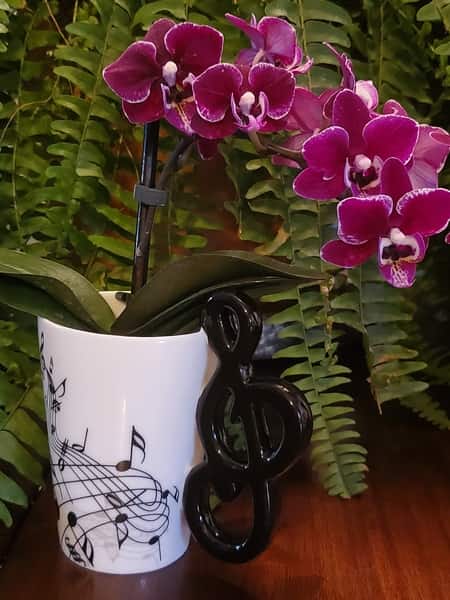
We’ve all done it. I certainly have. With a shopping list in my hands, I carefully walk through the aisles and pick out the items on my list, making sure that I don’t forget any ingredient.
Yet somehow, the flower section of the supermarket or grocery store draws me to it like a magnet. The so-called “jumper orchids” jump from the supermarket shelves right into our shopping carts.
This unparalleled and uncontrolled phenomenon occurs online, too.
Once home, you start unpacking the groceries and placing them in the shelves and cupboards. As you eye the beautiful yet uncertain stranger sitting on your kitchen countertop, questions start flooding your mind.
What now?
How do I water this thing?
How am I supposed to keep it alive?
Aren’t orchids the hardest plants to grow indoors?
To understand this new guest, you read the flimsy instruction card. Usually these will have three basic instructions:
1) give plenty of light but not direct sunlight;
2) keep the temperatures decent, as in around 65 to 85 F (18 to 20 C); and
3) water with 3 ice cubes a week.
This is where the problems begin… Let me say this first—no matter what that little card says, don’t follow it. I’ll explain why.
This article is where to start your orchid care as a beginner but most importantly, don’t ever stop learning. Always keep learning.
1. Grocery Store Orchids are Phalaenopsis Orchids
Orchids grow on literally every continent in the world except Antarctica. The majority of the orchids will grow in tropical and subtropical climates, but there are others that also grow in deserts, savannas, swamplands, plains, and every other climate.
For example, I wrote an article about desert orchids, or orchids that grow in dry places which you can read here. In any case, your supermarket orchid is not a desert orchid.
To understand your orchid, you need to know what genus it is. Genus is the bigger category of orchids, grouped by similar growing conditions and habitats.
Some of the most common genera (plural of genus) are Phalaenopsis—like you just bought, Dendrobium, Cattleya, Vanda, Brassavola, Oncidium, Miltoniopsis, and a whole gambit of mini orchids, like Dracula and Masdevallia.
The genus is then subdivided into species. The Phalaenopsis orchid—your grocery store orchid—has around 66 known and classified subdivisions called species.
There are several ways to also divided the Phalaenopsis orchids, as in cool-growing or warm-growing. If you want to know more about different types of orchids, read this article about orchid ID.
Another problem: the tag on your orchid really has no indication of what orchid you have, neither genus nor species.
Most grocery store orchids are Phalaenopsis, but some places, like Lowe’s, can also have Cattleyas and Oncidiums. It’s rarer, but before you keep reading, make sure your orchid looks like the one below.

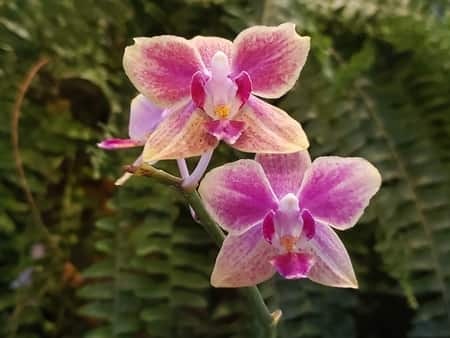
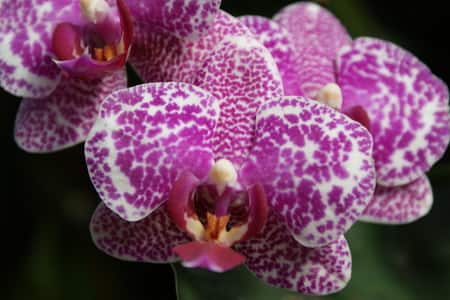
2. Grocery Store Orchids Need Sunlight to reBloom
All plants need some sort of sunlight, either natural or artificial. Orchids love to be in bright places, but hardly ever do they receive natural sunlight in abundance. Your grocery store Phalaenopsis will probably have been found naturally around a warmer tropical forest in the Philippines, Indochina, Malaysia, and New Guinea.
Over time, nurseries have found ways to produce these orchids in the United States and do not need to import them, which brings the price down considerably.
Back to the natural location of the grocery store orchid… These places all share the same elevation, temperature, light patterns, and humidity.
Phalaenopsis orchids grow attached to trees in nature, so they do not like to be potted.
Their roots will firmly grasp the tree bark about a third of the height of the tree. They do this because they need to receive more sun, and on the forest floor due to the dense overhead leaves, the sun doesn’t penetrate. Hardly any natural sunlight reaches the bottom of the forest floor.
Orchids had to find a way to get more sun. They receive about 80% filtered light, but yet are in bright places. To recreate this in your house, you’ll need to find a window that gets the morning sun for around two hours.
Without this source of sunlight, your grocery store orchid will not rebloom. Any more than that morning light for a couple of hours will provoke sun damage to the leaves. Sun damage can also be caused by heat damage. It’s not only the direct rays that will damage the leaves, but the temperature of the sun.
Overheating causes the leaf to open the gas exchange pores, called stomata, and remain open to let the temperature trickle off. This will lead to loss of humidity, which will in turn, dehydrate your orchid.
If your orchid is too hot, the leaves will start to develop deep grooves and appear leathery.
In the Continental United States, this eliminates the west-facing windows for most grocery store orchids. When I lived in Brazil, it also eliminated the north-facing windows, too. It all depends on where you live and how much sun your window gets.
For me, now that I am States-side and nestled in the farmlands of Kansas, I grow my orchids indoors. When I bought my current house, I hadn’t figured in the light/window aspect.
Murphy’s law would predict that none of my windows actually get a decent amount of sun. My east-facing window is so dark that nothing grows. My solution was to buy grow lights, and this is the model I ended up purchasing (Affiliate Link).
Take a small tour of your house in the early morning hours and look around at exactly how much light your orchid will get if places on each sill. If you come to the conclusion that no window is really good, then there is hope.
Don’t give up on your grocery store orchid.
You can purchase grow lights or artificial lights. There is a whole article about artificial lighting here, and how you can choose the best light for you.
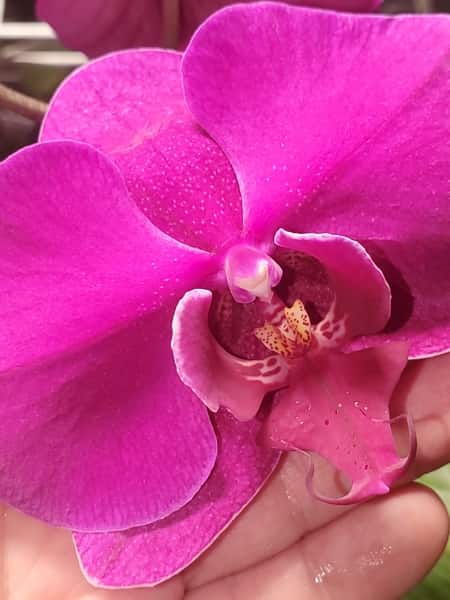
3. Grocery Store Orchids Need good Water to Bloom
No matter what the instruction card says, do not use ice cubes to water your orchids. I explain why in this article, but to summarize it, most all orchids are tropical and subtropical plants.
Your phalaenopsis orchid is, for sure. The temperature shock that the cold water provokes on the roots stun the root growth. The amount of water is never enough and the ice cubes do not hydrate the entire medium.
I use distilled water at room temperature to water my orchids.
Tap water, depending on where you live, can be extremely harmful due to the high percentages of chlorine and fluoride in the water. Also, the pH is usually way too high for orchids, which prefer a pH of around 5.5 to 6.5. Kansas tap water sits at 8.8.
If you are serious about growing this orchid, then I suggest getting a pH meter. You can find them at Aquarium shops, pet stores, and even at Amazon. I got mine for under 10 US dollars. It’s a tool that you don’t use all the time, but can give you some kind of indication in what direction you’ll be heading.
Most times, this pH meter will also come with a part-per-million meter, which tells you how many elements, minerals, and other “gook” is in your water. This is extremely important to know, because you want the best water for your orchid.
I won’t expand much more on that, since this article is strictly about reblooming, but if you want, check this other article out about the best water for your orchid. No matter what, using ice cubes is the best way to guarantee that your orchid will not rebloom properly.
Another thing that is important about watering your orchid is not only the best water to use but how much and how often. One of the biggest challenges for you as a new orchid grower is how much water to use. Over-watering is the number one problem of orchid death.
Over-watering can happen because of 2 things: too much water and watering too often. Take your orchid to the sink and if it is in the potting medium it came with, use so little water that you’ll think you’re killing it by dehydration.
Don’t worry…
That yucky potting medium is made for little amounts of water. Your orchid is accustomed to that amount, but won’t live long in it. I’ll get to that point in a little bit.
Once you trade your potting medium, you can use more water and your orchid will appreciate it. Orchids tend to be thirsty, and the three-ice-cube method just doesn’t cut it.
4. A Temperature Drop Encourages Blooms
In nature, the night cools off around 10F (11 C) depending on where you live. Even in the hot nights, orchids experience a cooler night than compared to day-time temperatures. To induce reblooming, this drop in temperature at night is essential.
You can achieve this drop in various ways. During winter, you can simply cut the heat supply in that particular room. The drop indoors should be around 10 degrees, no more though. During summer, I keep the overhead fan circulating on at night.
My Phalaenopsis orchids are more warm-growing orchids and I found out that I needed a heating pad during the severe winter storms of Kansas. At night, during the colder months, I keep a heating pad under them just to guarantee that the drop in temperature is not too severe.
I use this heating pad (Affiliate Link)  but came to change my mind later. I recommend others on this page. It’s just the cheapest one I found at the time and I kind of regret that not.
but came to change my mind later. I recommend others on this page. It’s just the cheapest one I found at the time and I kind of regret that not.
It’s been told that this temperature drop needs to be constant month after month, but I have found out that if you do this for a little over a month, that’s all you really need. It’s best if you can keep that drop year-round, but if your focus is only reblooming your supermarket orchid, then one month is enough.
5. To Rebloom a Grocery Store Orchid, Add Fertilizer
Did you notice that there is nothing mentioning fertilizer on the instruction card? Nope… so sad. Anyway, supermarket orchids do not live on water alone. No one does, for that matter. We all need a decent supply of food, a balanced diet, and nutrients in small portions several times a day.
This is where the fertilizer begins. Grab a bag of orchid fertilizer (if you need help choosing, read this article I wrote about the 5 types or methods of fertilizing orchids) and use a tiny, winy, little-bitty, portion 3 of the four weeks you water.
There are three numbers on the fertilizer bag, called an N-P-K ratio, and that is the amount of Nitrogen, Phosphorus, and Potassium that each bag has. Whatever you use, get one that is proper for orchids. Other household plants have different requirements.
When it comes to fertilizing, go back to think about how orchids grow in nature. In the tree-tops (or the upper 1/3) the orchids will receive nutrients that float on the wind currents. Their aerial roots will capture these nutrients, along with any water droplets that are in the air. This is called relative humidity.
When it rains, and let me tell you something—in Brazil, when it rained, it poured. Down poured, like torrential floods that would stop in an hour or two but come back the next day to do the same.
That rain falls on the overhead leaves in the forest canopy. These leaves have animal droppings, leftover fruit that were half-eaten, flower pollen, and all other kinds of elements rich in nutrients.
The rainwater that runs in the grooves of the tree bark will bring tannins with them, which are high elements of antioxidants. We can get these tannins by drinking tea, which a lot of orchid growers like to use. If you’re curious about using tea as an orchid fertilizer, read this article.
In summary, the orchid will receive 24 hours of nutrients in tiny doses 7 days a week. The amount of nutrients is constant yet minute. For your grocery store orchid, you’ll need to provide ¼ of the recommended dose of fertilizer for your orchids. Water with this solution three of every four weeks.
In this free guide below, you can read all about fertilization and what is best for your orchid. I also included ways to use natural fertilizers, too, if you are against the store-bought ones.
The last item I want to point out about fertilizing is that too much fertilizer does more harm than no fertilizer at all. Your orchid will need fertilizer but watch the doses.
6. Grocery Store Orchids need Humidity to Rebloom
To make your grocery store orchid bloom again, the same conditions that are found in nature need to be recreated in your home. This includes humidity.
Most grocery store orchids need from 40 to 60% of relative humidity to maintain a healthy root and leaf system. Any lower than that, the aerial roots will start to dry up and the leaves will not perform appropriate gas exchange.
Remember when I mentioned that hot air will open the stomata on the bottom side of the leaves? This happens because the leaves need to let off the excess heat they have built up during the day.
The leaves are responsible for gas exchange as are orchid roots. The number one reason you need to have your orchid in a ventilated pot is exactly that: the orchid roots need to breathe and absorb water droplets from the air.
If the relative humidity in your home oscillates from 27 to 33%, an orchid in nature lives in much wetter climates. The quantity of water droplets in the air will be much higher in their natural habitat, and you need to raise that level of water circulating in the air. To do this, you can buy a humidifier or use a humidity tray.
Since Phalaenopsis orchids—at least the ones you buy in supermarkets—do not require that much humidity, and can go by without the use of a humidifier. In their case, a humidity tray will work.
Keep in mind though that the humidity tray will only raise the humidity 2-4% and only up to 2 inches on the sides of the orchid pot. If you have a massive orchid in a tall pot, humidity trays don’t really help all that much. If you see the aerial roots starting to shrivel, then it’s a sure tell sign that it’s time to purchase a humidifier.
When I purchased mine, I wrote down my whole research process to figure out what was the best one to buy. I can’t recommend mine directly because I don’t know your growing conditions or climate. My suggestion would be to read through that article and make notes of what would work for you.
Phalaenopsis orchids will not rebloom if they can’t breathe correctly. This happens because the stomata are closed. Since they can sense the low humidity, they don’t want to open their breathing mechanisms to lose the little humidity they have. So, they maintained closed.
The toxic levels raise due to non-functional gas exchange, and the leaf starts to break down from the inside out. The leaf will wither and dry out. To learn how to manage the correct humidity, read this article I wrote on relative humidity for orchids.
7. Decent Potting Medium promotes flower spikes
The potting medium—what the orchid is potted in—is usually a brownie-like, cakey-dry gelatin yucky junk. That’s officially my technical definition. It worked for a short time just to get the orchid sold, but in the long run, it needs to be removed.
The roots should be plump, fat, and green. You should be able to see them through the pot and that is the best way to tell if your orchid is healthy. A healthy orchid has healthy roots, so don’t think that your orchid is healthy because it has a nice bloom.
Anyway, the roots will rot if kept in this potting media for long. This original supermarket potting medium is a mixture of peat moss and other substances that will suffocate your orchid over time.
To sell grocery store orchids, which will be placed in a super dry climate (supermarket orchids are exposed to extremely low relative humidity, so usually you’ll see them by the produce section where humidifiers are already spritzing the vegetables to keep them green and luscious) the potting medium needs to retain as much water as possible.
This super-absorbent potting medium does not handle water well. It is made to absorb the trickling water that melts from the ice cubes. To do a small experiment, melt three ice cubes in a cup and measure how much water that actually produces—not much.
This extremely low quantity of water is not the best for the orchid, but to survive the weeks on the grocery store shelf, it doesn’t need much.
After the blooms have fallen off, you’ll want to repot your orchid. Clear its roots of all that horrible potting medium and repot it in a vase with lots of holes. Use an orchid bark and sphagnum moss potting medium.
Depending on your climate, you’ll need to find a potting medium that works best for you. I suggest reading this article about sphagnum moss and this other about the best potting medium for each orchid.
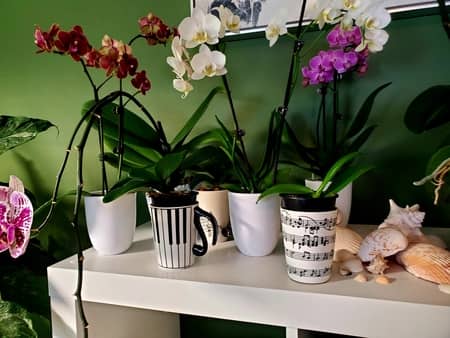
8. How to Get Your Supermarket Orchid to Rebloom
Finally, the part you’ve been wanting to read for the entire article. Once the blooms have fallen off and you’ve provided the care above, knowing that you’ve done your best, your Phalaenopsis orchid will need to make one of two choices. You can help it decide.
The supermarket orchid can either work on developing new leaves and more healthy roots, or it can focus on a new flower spike. If the orchid had a hard year, I suggest leaving the flower spike for another time.
Flower spikes consume a tremendous amount of energy. So much energy, that some orchids go into a period of dormancy, like the Catasetum and the Dendrobium orchids.
Phalaenopsis orchids do not go into dormancy, but they will be extremely weak.
They need a break. If you’ve had your orchid for a year and it’s the second item around for it to bloom, then yes, induce your orchid to rebloom. It hasn’t gone through much this year and can handle the stress of another rebloom.
How do you induce an orchid bloom? By cutting the spent flower spike close to the top, right after the least flowering node, you can induce the grocery store orchid to rebloom. Supermarket orchids are “bred” to rebloom. Orchid growers want to make money off them and nobody buys an orchid that isn’t in bloom.
HINT: Rescue orchids, by the way, are cheaper and a great deal… When the supermarket orchids blooms die off, big box stores push them away in a dark, gloomy corner and are left to die. These are great projects and just like buying an old car, it’s the best way to learn about mechanics—or orchid care. A new car teaches you nothing.
By cutting the flower spike back to the closest node near the stem of the orchid, you will force the orchid to focus on new roots and leaves. When you have a sick orchid, this is the best solution: cut the spike back.
The amount of energy used to produce a new flower spike is so much that the orchid needs to decide whether it will focus on new flowers or new roots. The orchid cannot perform both tasks.
In summary, to get a Phalaenopsis supermarket orchid to rebloom, you need to recreate the same conditions that are found in nature. These include the filtered morning lighting for 2 hours; the correct relative humidity of 40 to 80%, the right water supply, amount, and frequency; and potted in a medium that recreates the side of a tree.
This article was just the starting point, but to really dive deep into orchid care, then keep on reading about each of these topics.
I suggest the following articles to get a whole overview of orchid care and from there, start specializing in one specific orchid. Another good idea is to join orchid societies and orchid talks. Group forums also answer a lot of questions that come up sporadically. If you live in the Untied States, the American Orchid Society is a good place to start.
is a good place to start.
How to Know if Your Orchid is healthy – This article talks about 13 signs to keep an eye on that indicate if your orchid is healthy or not
The Benefits of Adding Charcoal to your Orchid – Charcoal is one ingredient that only brings positive vibes to your orchid growth
Don’t Stop Learning!
If you want to be included in more information and get a 14-page fertilization guide, please sign up for my newsletter. I don’t spam, but send emails out bi-monthly with some curious topics of interest. If you want more information, click here to go to a specific page on this website where I explain it more in detail.

Also, if you are looking for an orchid journal to keep your notes specifically about orchid care, check out my 2 solutions for that on this page. If note-keeping isn’t your thing, then there is a free excel spreadsheet that you can download. Click here for more information on how to do that.
If you subscribe to my newsletter, I will send you a 14-page guide on the main tips of orchid fertilizer. It is downloadable and you can print it out on your computer. I designed the guide to double up as a coloring book, just to make it fun.
I wish you the best in your orchid care, and once you’ll see how easy orchids are (if you have the right information) this first-time orchid, your grocery store orchid, will grow on you like an addiction—in a good way.
Happy Cultivating!


My “grocery store” phalaenopsis orchids rebloom however the flowers are much smaller than when I purchased them originally and the stems are shorter. Is this to be expected?
I have tiny bugs almost like fruit fly size. How do I treat?
I cut my blooming spike down low. Now I notice there are two healthy looking roots growing. One has grown over the top of its pot. Sounds like I need to re-pot. Not sure what size to use and do I have to wait another year for re-blooming. I found you information most helpful. Thank you
I have a supermarket orchid that was given to me 3 years ago. I keep it on a window sill in the bathroom where it gets light all day, especially in the morning where it gets eastern sun. The glass is not frosted but it does block the heat of the day here in Austin Texas. Since this is a bathroom we use to take showers in, it gets lots of humidity. I repotted it several times in a special orchid potting mix made up of mostly wood bark. I water once a week, alternating feeding with a diluted orchid food every other week. I actually let the pot soak in the water for a couple of hours so that the chips get to thoroughly absorb the water. My orchid has bloomed almost every day for the 3 years. When all the flowers on the stem have opened it develops a new leaf. It always has 6 to 7 leaves. Right now it has 3 flower stems, the flowers buds on the last stem just starting to open now. This has been a hit or miss project since my first orchid died as soon as the flowers were spent. Looking back I can see where I went wrong, in many ways!
Hi Judith!
Thank you so much for leaving that comment. I usually don’t advise leaving orchids in bathrooms, but yours seems to love it there, so don’t move it.Great job in keeping the orchid healthy and thriving.
-Amanda